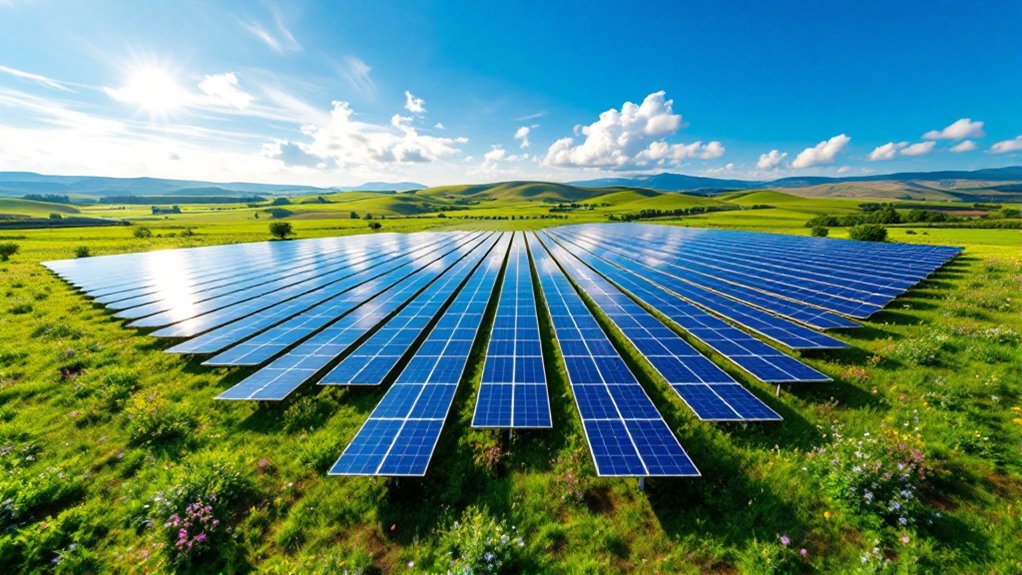
Solar Panels: How They Transform Sunlight
Solar panels play a significant role in converting sunlight into usable energy. They utilize a process known as the photovoltaic effect, where sunlight excites electrons in silicon cells. This results in the generation of electricity, which is fundamental for modern households. Understanding how these systems function and their components is important. The implications of this technology extend beyond energy efficiency, raising questions about its future impact on energy sustainability.
The Basics of Solar Energy Conversion
Solar energy conversion involves the process of transforming sunlight into usable energy, primarily electricity. This transformation begins when solar radiation strikes a material, generating an electric current through the photovoltaic effect. Photons from sunlight interact with electrons in the material, freeing them and creating a flow of electricity. The efficiency of this conversion depends on several factors, including the intensity of sunlight, the angle of incidence, and the properties of the absorbing material. Additionally, solar energy can be harnessed thermally, where sunlight heats a fluid to produce steam that drives turbines. Understanding these fundamental processes is essential for optimizing solar energy usage and advancing technologies aimed at enhancing energy efficiency and sustainability in response to growing energy demands. Moreover, the renewable energy sector is a significant source of job creation, highlighting the broader impact of solar energy on the economy.
Components of a Solar Panel
A solar panel consists of several key components that work together to convert sunlight into electricity. The most critical component is the photovoltaic (PV) cells, which absorb sunlight and initiate the conversion process. These cells are typically made of silicon, a semiconductor material. Additionally, the panel includes a protective glass layer that shields the cells from environmental damage while allowing sunlight to penetrate. Beneath the cells, a backing material provides structural support and insulation. The frame, usually made of aluminum, offers durability and facilitates installation. Finally, junction boxes house electrical connections, ensuring safe and efficient energy transfer. Each of these components plays an essential role in maximizing the efficiency and longevity of the solar panel system. Furthermore, the adoption of renewable energy technologies like solar panels contributes significantly to sustainable living practices by reducing reliance on fossil fuels.
How Photovoltaic Cells Work
Photovoltaic cells play an essential role in converting solar energy into usable electricity. This process involves the movement of electrons within the cell, triggered by the absorption of sunlight. Understanding this mechanism is key to appreciating how solar panels generate power. Additionally, advancements in AI technology are enhancing the efficiency of solar energy systems and their integration into smart grids.
Solar Energy Conversion
When sunlight strikes a photovoltaic cell, it initiates a series of reactions that convert light energy into electricity. The photovoltaic cell contains semiconductor materials, typically silicon, which absorb photons from sunlight. This absorption excites electrons within the semiconductor, enabling them to break free from their atomic bonds. As these free electrons move, they create an electric current. Additionally, the semiconductor is designed with a junction that establishes an electric field, directing the flow of these electrons toward the external circuit. This process effectively transforms the energy from sunlight into usable electrical energy, providing a renewable power source. The efficiency of this conversion depends on the materials used and the design of the photovoltaic cell itself.
Electron Movement Process
Sunlight triggers a complex process within photovoltaic cells that leads to the movement of electrons. When photons from sunlight strike the surface of the solar cell, they transfer their energy to electrons in the semiconductor material, typically silicon. This energy absorption excites the electrons, allowing them to break free from their atomic bonds. As electrons gain kinetic energy, they flow through the material, generating an electric current. The design of the photovoltaic cell includes a built-in electric field that directs the movement of these free electrons towards conductive layers. This organized movement of electrons ultimately produces electricity, which can be harnessed for power. Consequently, the electron movement process is fundamental to the operation of solar panels.
The Role of Inverters in Solar Systems
In a solar energy system, inverters play an essential role in converting direct current (DC) generated by solar panels into alternating current (AC), which is the form of electricity commonly used in homes and businesses. This conversion is critical because most household appliances and the electrical grid operate on AC. There are various types of inverters, including string inverters, microinverters, and power optimizers, each serving different system configurations and performance needs. Additionally, inverters monitor the system’s performance and manage energy flow, ensuring maximum efficiency. They also provide safety features, such as disconnecting the system in case of grid failure to protect both the solar installation and utility workers. Overall, inverters are crucial for integrating solar energy into daily electricity consumption. The shift towards advanced collaboration tools in various industries parallels the importance of efficient energy management systems in solar technology.
Benefits of Using Solar Energy
Solar energy offers numerous advantages that extend beyond the technical aspects of inverters. One significant benefit is the reduction in energy bills, as solar panels can generate electricity, thereby decreasing reliance on traditional power sources. Additionally, solar energy is a renewable resource, contributing to environmental sustainability by lowering greenhouse gas emissions. This clean energy source also enhances energy independence, allowing individuals and communities to generate their own power. Moreover, solar energy systems can increase property value, making homes equipped with solar panels more attractive to potential buyers. Finally, government incentives and tax credits can further alleviate the initial investment costs, making solar energy an economically viable choice for many households and businesses. Furthermore, embracing minimalism in lifestyle can complement the use of solar energy by promoting simplicity and reducing overall consumption.
Future Trends in Solar Technology
How will emerging technologies shape the future of solar energy? Innovations such as perovskite solar cells are set to revolutionize efficiency and cost-effectiveness. These materials promise higher energy conversion rates compared to traditional silicon cells while potentially reducing manufacturing costs. In addition, advancements in solar panel recycling techniques aim to address sustainability concerns, ensuring that obsolete panels do not contribute to environmental waste. Furthermore, the integration of artificial intelligence in energy management systems will optimize energy production and consumption, enhancing grid reliability. Additionally, the development of building-integrated photovoltaics (BIPV) will facilitate the seamless integration of solar technology into architectural designs, making solar energy more accessible. Together, these trends signify a transformative era for solar technology, paving the way for greater adoption and sustainability.
Frequently Asked Questions
How Long Do Solar Panels Typically Last Before Needing Replacement?
The lifespan of solar panels generally ranges from 25 to 30 years. However, performance may gradually decline after the first decade, leading to reduced efficiency and potential replacement to maintain peak energy production.
What Maintenance Do Solar Panels Require Over Their Lifespan?
The maintenance of solar panels primarily involves regular cleaning to remove debris and dust, periodic inspections for damage or wear, and ensuring that the inverter and electrical components are functioning efficiently throughout their lifespan.
Can Solar Panels Work Effectively in Cloudy Weather?
Cloudy weather can reduce solar panels’ efficiency, but they still generate electricity. Their performance may decrease by 10-25% under overcast conditions, yet they remain functional and contribute to energy production even in less-than-ideal sunlight.
How Do Solar Panels Impact Property Value?
The impact of solar panels on property value varies; many studies indicate an increase in resale price due to energy savings and environmental appeal, while others suggest minimal effects depending on location and market conditions.
Are There Financial Incentives for Installing Solar Panels?
Financial incentives for installing solar panels include tax credits, rebates, and grants. These programs aim to reduce installation costs, encourage renewable energy adoption, and promote sustainability, ultimately benefiting both homeowners and the environment economically.
Conclusion
In summary, solar panels play an essential role in converting sunlight into usable electricity through the photovoltaic effect. By understanding the components involved, such as photovoltaic cells and inverters, one can appreciate the efficiency and effectiveness of this renewable energy source. As technology advances, the benefits of solar energy continue to expand, offering sustainable solutions for reducing carbon emissions and supporting global energy needs. Embracing solar power paves the way for a cleaner, greener future.



